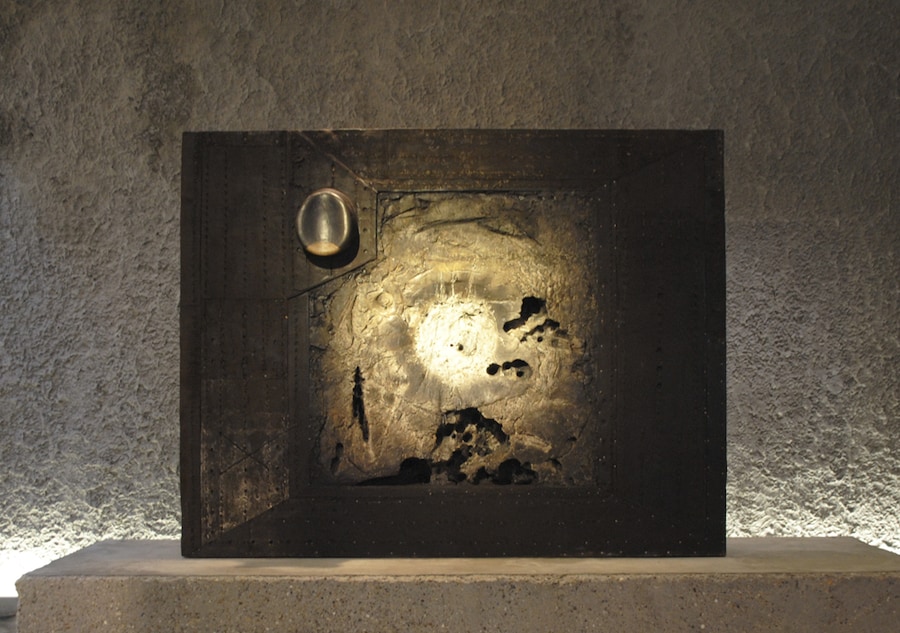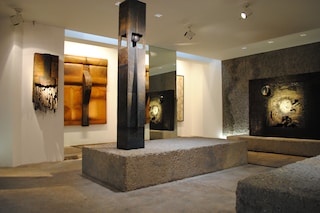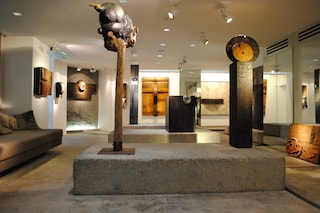The German artist exhibits his work at the designer's London store and speaks to us about his self-portraits and love of leather
At Horst Egon Kalinowski's latest retrospective, soft salvaged skin warps onto wood work, adorned by rusted manacles, abstracted onto concrete plinths and re-born as high fibre moral characters that tug and pull at our dispossessed emotion. Works like a leather wall sculpture that fashion’s dark star Rick Owens says he “simply had to have”. Work Kalinowski treats as self portraiture, in a style opposed to geometric abstraction that has found itself in New York’s MoMA and Paris’ Pompidou Centre prized art collections. Work, which as luck would have it, Owens and his wife Michele Lamy couldn’t resist buying again a year later at Biennale Antiquaires.
“Robert from RCM Galerie found out we had [the two artworks] and knew us so offered to set an exhibition up,” recalls Owens. “I was delighted to have the chance to share my enthusiasm for Mr Kalinowski. His work has a brutalist fetish elegance that in my own small way I try to capture with my clothes”. So hearing a rare show of Kalinowki’s relief and sculpture was to be exhibited at the Rick Owens store in London, Dazed took the chance to sit down with the artist to speak about his thoughts on language, feeling and materials.
Dazed Digital: When did you first know you wanted to express yourself through leather?
Horst Egon Kalinowski: I like the touch of leather, the sensation where it seems to have no start or end, the sensation you gain between yourself and the material, I like to feel the difference of material, if it’s fine or brutal. Of course you can even feel material with your eyes but when I take material in my hand it is also becomes so much more than painting where you simply push colour out of a tube.
My style began when I was studying at the academy and I began to feel deeply unsatisfied with the limitations of pastel colours and so I tried to find out which material could explain me and my own feeling. At the time it was really only with my own clothes that I knew how to express myself but a voice in my head said ‘begin with this.’ Instead of copying a skin however, you take a skin and make it into artwork.
DD: Your artworks are made to evoke a feeling, which you have felt?
Horst Egon Kalinowski: Yes because I have a feeling inside my body, a feeling you can sense through your nose, eyes, ears all the different sensations that aggres me. So something as simple as all the tiny strings in one of my art works is also an expression of the pain in life.
DD: You’re expressing this feeling through sculpture but by allowing it to become art you’re denying anybody’s ability to touch that material...
Horst Egon Kalinowski: When you write a letter or when you draw there is a pleasure in using a pen to create. So it’s the same here: you try to find out the material, to explain, because you have a need to explain, to speak with your friend or your girl to explain why you are so nervous, why you are feeling like this or aggressed by the presence of something. [Kalinowski points at the gallery walls]. Look at this wall; it’s not only a painted wall. You can see the way it’s been painted explains a painful situation. There is baff or a blaff and it is fact of the action, it is painting with action.
DD: Are these works autobiographical for you, are they almost self-portraits?
Horst Egon Kalinowski: Yes, life is full of so many impressions that you cannot keep all together, you have a need to lust and you have a need to explain what you have felt, to share with people what other people have not felt. So you make acquaintance about your feeling with other people. It’s another way of speaking with you. I can say to you, look at this, this is my work.
DD: Can you explain how you title your works?
Horst Egon Kalinowski: A title is for me like a little boy, you give him a name and the name, during his life, can be finally the character, of the man. They are almost helpless to keep their individuality from anyone. He could speak with you because you call him by his name and the title which I have given to my work, it’s not a description, it does not illustrate anything and it’s only a suggestion.
DD: Why do you use old materials and clothes in particular?
Horst Egon Kalinowski: There is a big difference with new clothes because when you begin to get involved with the clothes then the material is going to go larger or smaller and plus en plus you use it and more and more the clothes take the form from yourself until perhaps you prefer to have clothes that have given you pleasure many times so much so you cannot throw them away just because they’re old. No you prefer to keep it for a very long time and it gives you a warmness back you do not feel with something new.
DD: So when you collect from old clothes markets you’re almost collecting other people’s stories?
Horst Egon Kalinowski: I see something and I want to give the words to express the feeling inside the material. All these pieces can be said to come from animals... this is not important for me, for me it is important that I have felt a material and explain it. So I am going from one to another plinth, from one to another form and I hope finally it all speaks one language through the emphasis, the feeling, the colour and the form you have identified with.
Rick Owens, 64 South Audley Street, London W1K 2QT







